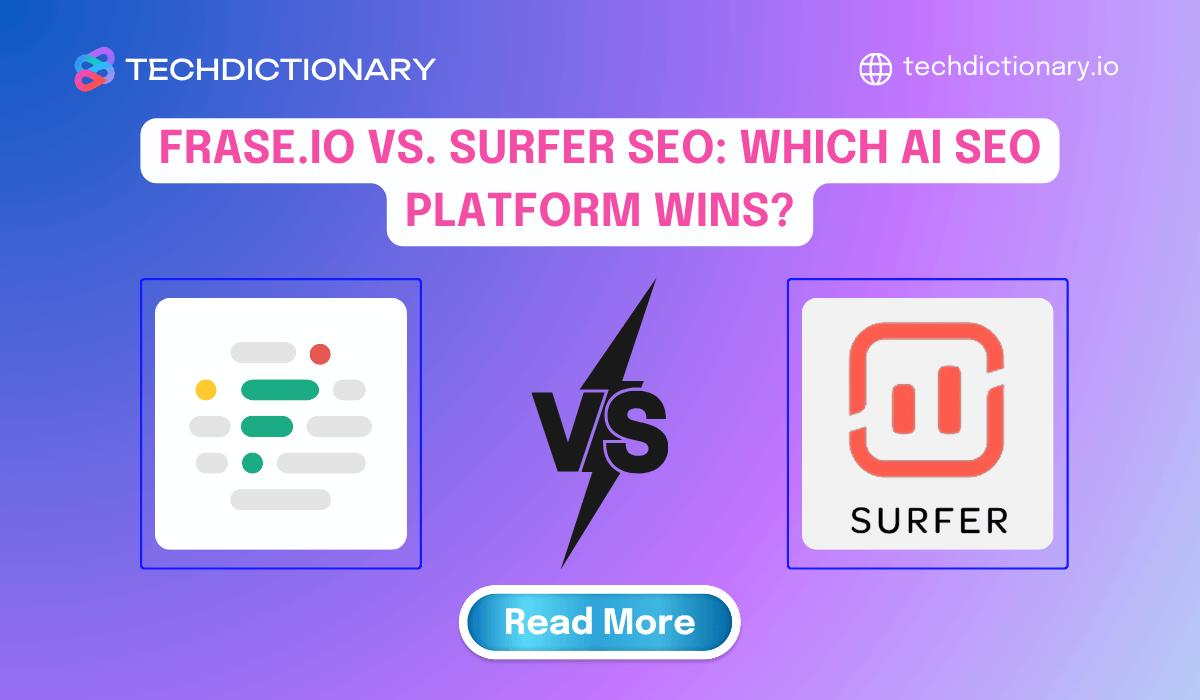
As a team of writers whose success is measured by SEO performance, our old workflow of scattered tools finally hit a wall. We landed a high-stakes SaaS client who made one thing clear: they were paying for rankings, not just words.
This forced a critical debate within our team: should we double down on a tool that perfects our research and drafting speed or a data-driven machine built for pure optimization?
This led us to the showdown: Frase.io vs. Surfer SEO. We invested our own money in both and put them through a 3-month trial on that very project. This is our honest report on which tool is the smarter investment for writers who need to win. Let’s dive in!
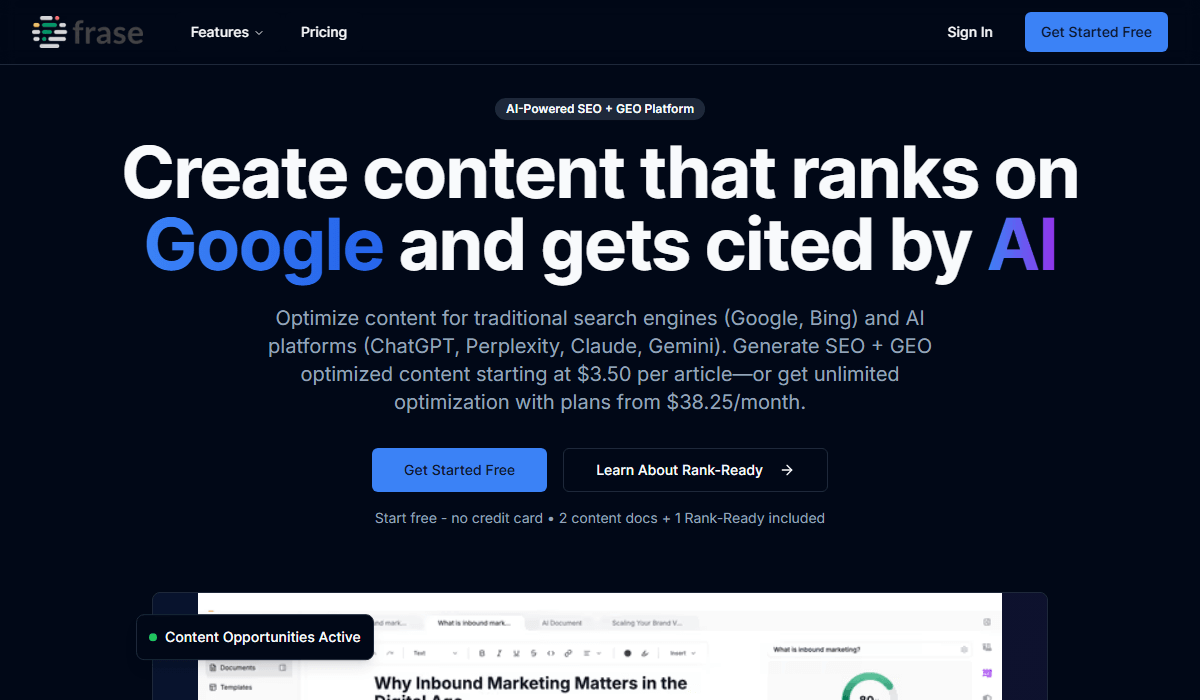
Frase is an AI tool that combines SEO and GEO for optimized content
Frase is an AI-powered platform designed to help you research, write, and optimize content. It offers a suite of tools that cover the entire content creation lifecycle, from analyzing search engine results to generating full-length drafts.
For us, Frase acts as our “Content Creation Hub”—the central platform that takes us from a single keyword to a complete, well-researched first draft. What makes it essential for us today, however, is its crucial added dimension: GEO (Generative Engine Optimization). This approach ensures our work is no longer just optimized for Google; it’s strategically built to be trusted and cited as a source by AI platforms like ChatGPT, making every piece of content we create work twice as hard.
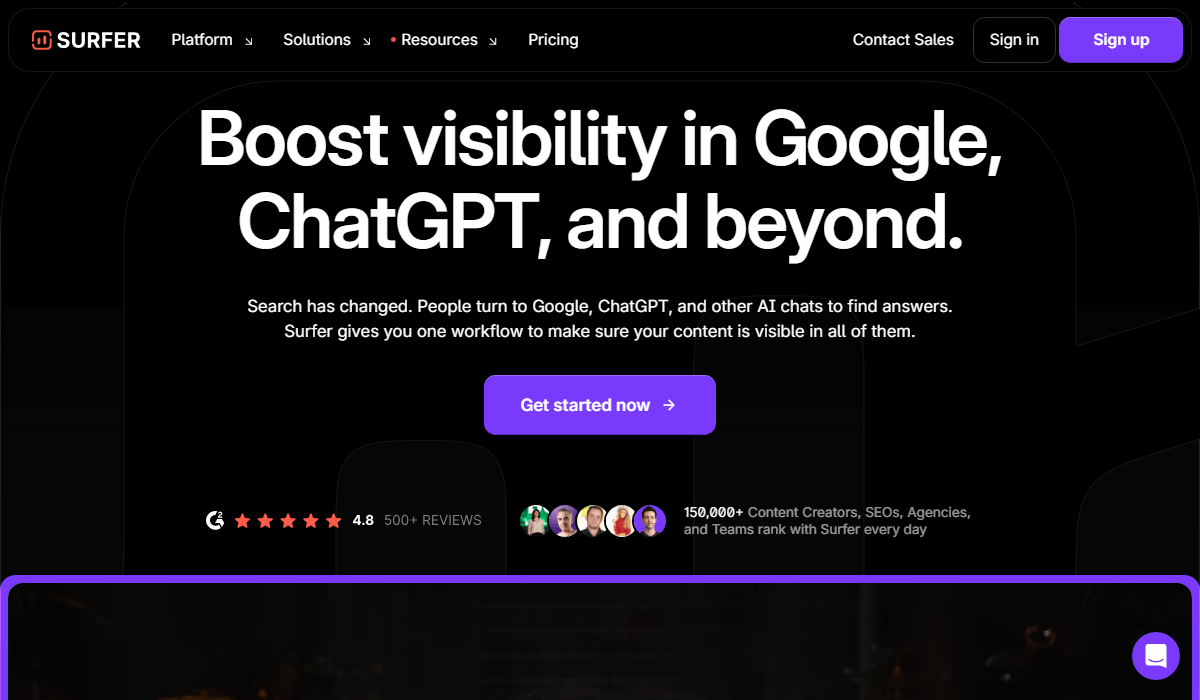
Surfer SEO is a data-driven tool for on-page optimization
Surfer SEO is a content intelligence tool that focuses intensely on the on-page optimization aspect of content. It analyzes top-ranking pages to give you a data-driven blueprint for what your article needs to include to have the best chance of ranking.
We view Surfer as an ‘SEO Optimization Lab’. Its job isn’t primarily creation; it’s to scientifically refine and polish your content with data to win on the search engine results page.
To make this comparison as real as possible, we’re going to walk you through a typical project that landed on our desk.
The Scenario: A new client, a promising SaaS startup, hired us to write a foundational blog post for their content marketing. The Topic: “Best project management software for small business.” The Goal: Create a comprehensive, long-form article that not only provides genuine value to the reader but is also heavily optimized to rank for this highly competitive keyword.
Our typical workflow for a project like this involves five critical stages. Let’s see how Frase and Surfer handled the pressure at each step.
This is where every great article begins. The goal is to understand the search intent, see what competitors are doing right, and find gaps we can exploit.
We started by plugging our keyword, “best project management software for small business,” into a new Frase document. A “Research” pane immediately populated on the right. This is what blew us away: Frase didn’t just give us a list of URLs. It acted like a research assistant who had already read everything for us, organizing the key intel into clean tabs:
It felt like having a complete competitive analysis handed to us on a silver platter in under 60 seconds.
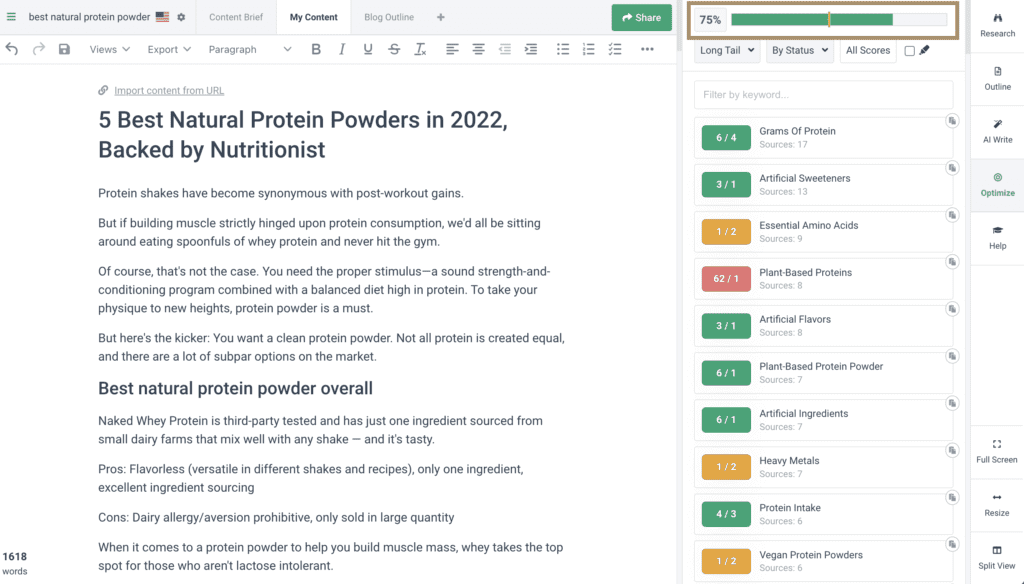
Frase excels in research and competitor analysis
We did the same in Surfer’s Content Editor. The right-hand sidebar is also populated with data, but with a different focus. Instead of summarizing the SERP for strategic insight, Surfer immediately gave us an optimization checklist:
Surfer’s research is laser-focused on the “what”—the specific ingredients you need to rank. Frase is focused on the “why”—understanding the landscape so you can build a better strategy.
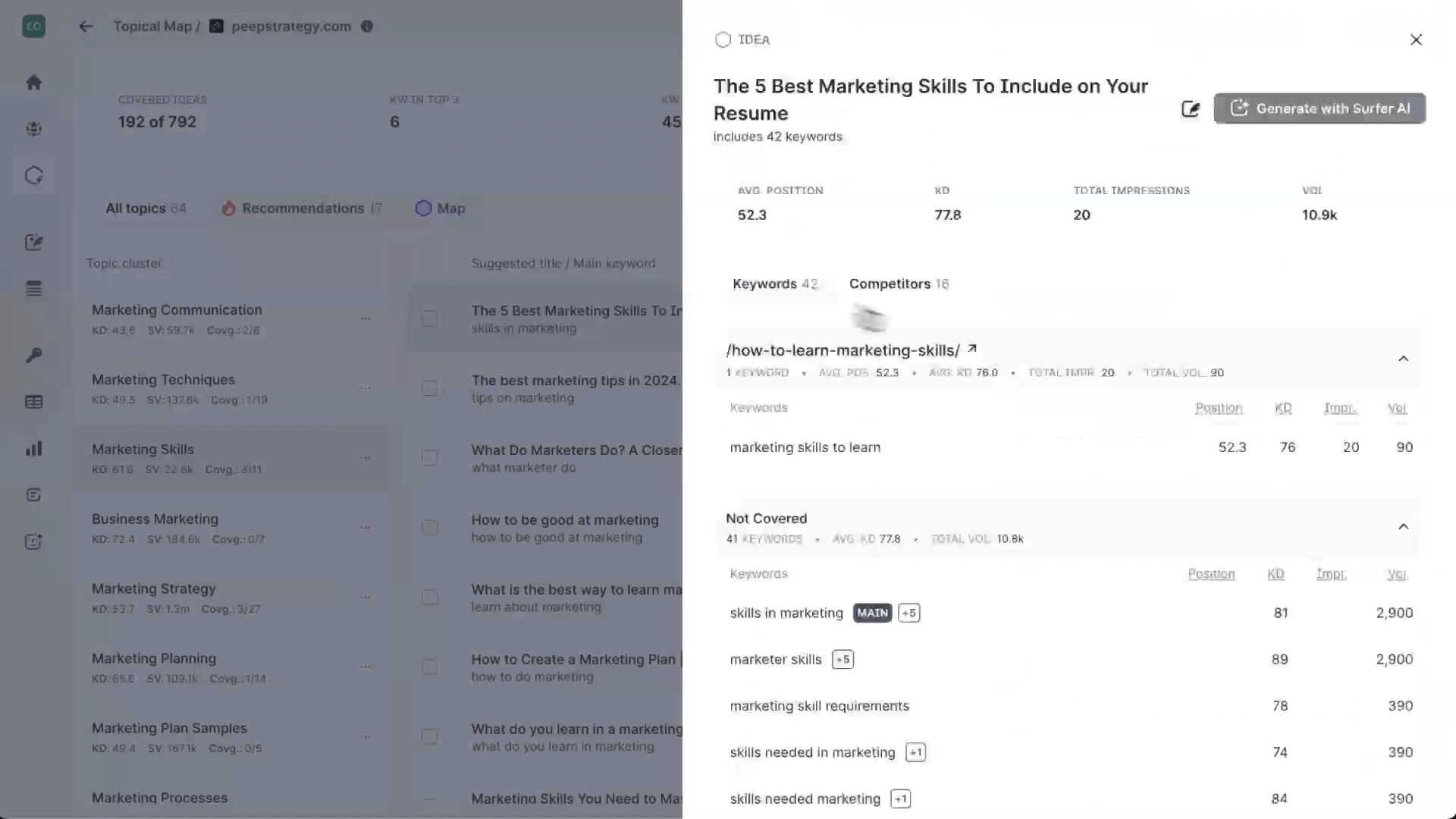
Surfer SEO focuses on providing an optimization checklist for content
Winner: Frase.
For the initial research phase, Frase is in a league of its own. It saved us an incredible amount of time. Instead of spending hours manually clicking through SERPs and copy-pasting headings into a separate document, Frase gave us a strategic overview instantly. This allowed us to spend our brainpower on analyzing the information, not just gathering it.
With our research done, the next step was to build the skeleton of our article.
This is where Frase’s research seamlessly transitions into creation. We used two key features:
We could then easily drag-and-drop these sections, combining the best of the SERP with our own unique angle. The process felt like building with LEGOs—creative, intuitive, and fast.
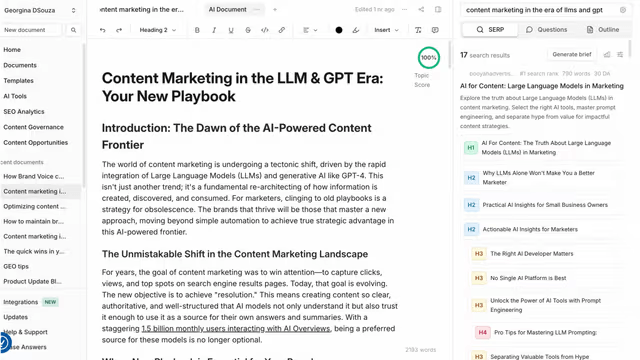
Frase creates content outlines by combining research and structure
Surfer’s AI-powered “Outline Builder” took a different path. It generated unique, AI-written titles and headings. For our project, it suggested sections like “Unlock Peak Productivity with These Tools” and “Key Features Every Small Business Needs.” While some of these were decent starting points, they felt generic and disconnected from the deep SERP data. It was more of an “idea generator” than a “structure builder.”
Using Frase to create an outline is like an architect finalizing a detailed blueprint before construction begins. It provides a logical, research-backed foundation. Surfer’s approach is more like a builder getting a list of materials (keywords, topics) and some general ideas for rooms. Both are useful, but the detailed architectural plan is what ensures the final structure is sound.
Winner: Frase.
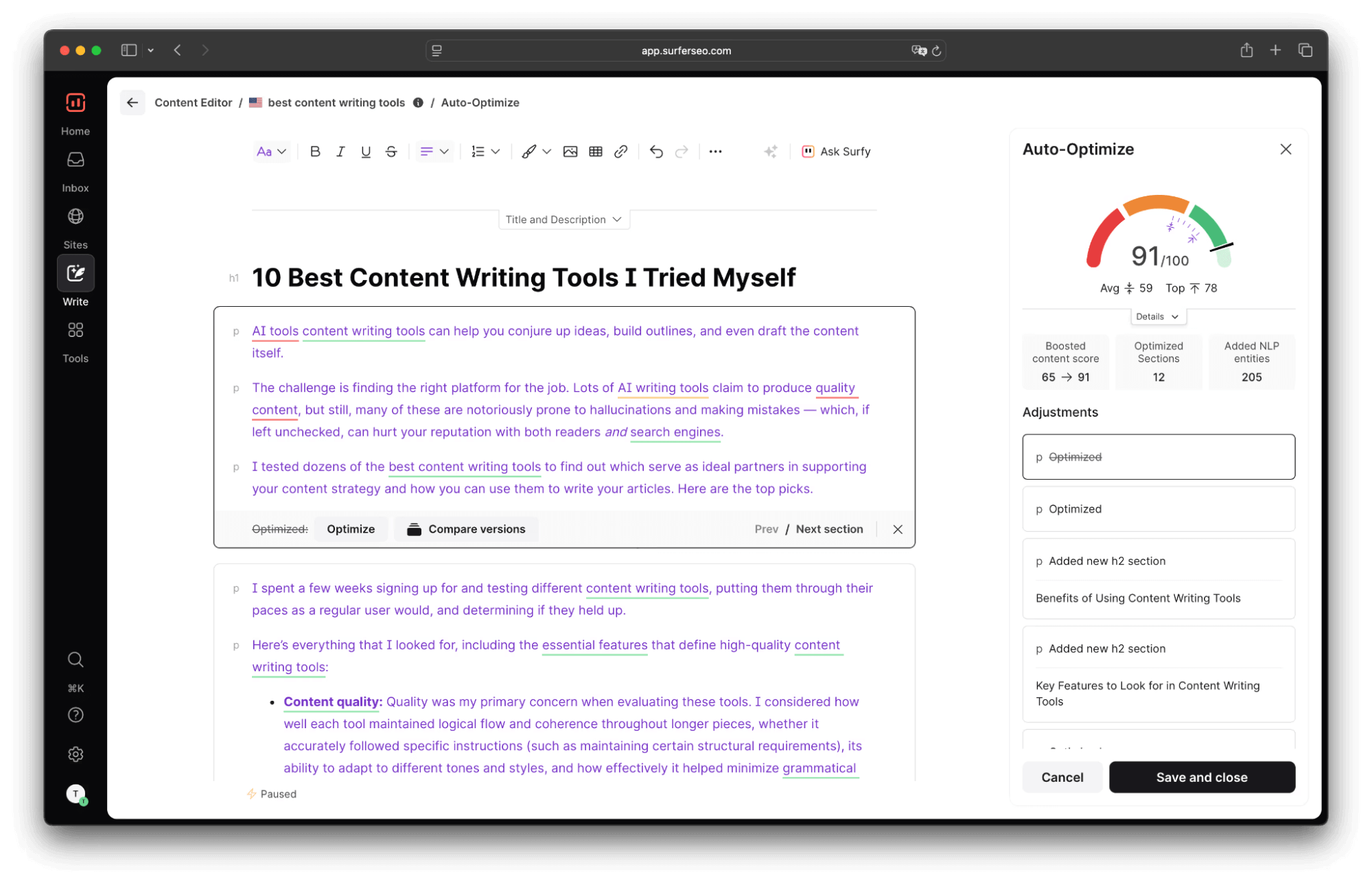
Surfer SEO generates AI titles, but lacks detailed outlines
Now for the heavy lifting: turning the outline into a first draft.
Frase’s AI is a core part of its editor. We could highlight any heading in our outline, like “Top 5 Features to Look For,” and use the “Write About This” command. It would then generate a well-structured paragraph. More powerfully, it has a vast library of AI Templates. We used the “Listicle” template to draft the main review sections and the “Introduction” template to get started. For sheer speed, its ability to write a full article from just a title is unmatched for overcoming the dreaded “blank page” syndrome.
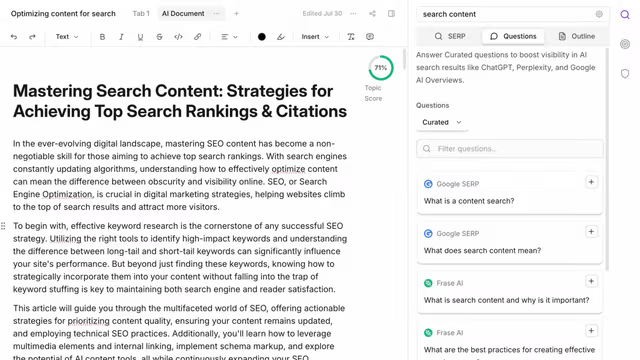
Frase quickly generates drafts using AI templates
Surfer’s built-in AI has evolved significantly. It can now generate full-length articles from a single keyword, complete with unique headings and paragraphs designed to meet its own SEO guidelines. Its core strength remains its deep integration with the SEO checklist; the AI’s primary goal is to write content that satisfies the Content Score from the outset. While it doesn’t have the extensive library of creative templates that Frase offers for varied tasks, its raw article-writing capability is now a direct competitor.
We must be honest here: no AI writes a publish-ready article. Frase’s AI produces an excellent “B+ grade” first draft. It saved us roughly 50% of the raw writing time. The other crucial 50% was our human effort: fact-checking, adding our team’s unique insights, refining the tone, and injecting storytelling to elevate it to an A+ piece. AI is your co-pilot, not the pilot.
Winner: Frase (for its built-in versatility, speed, and value).
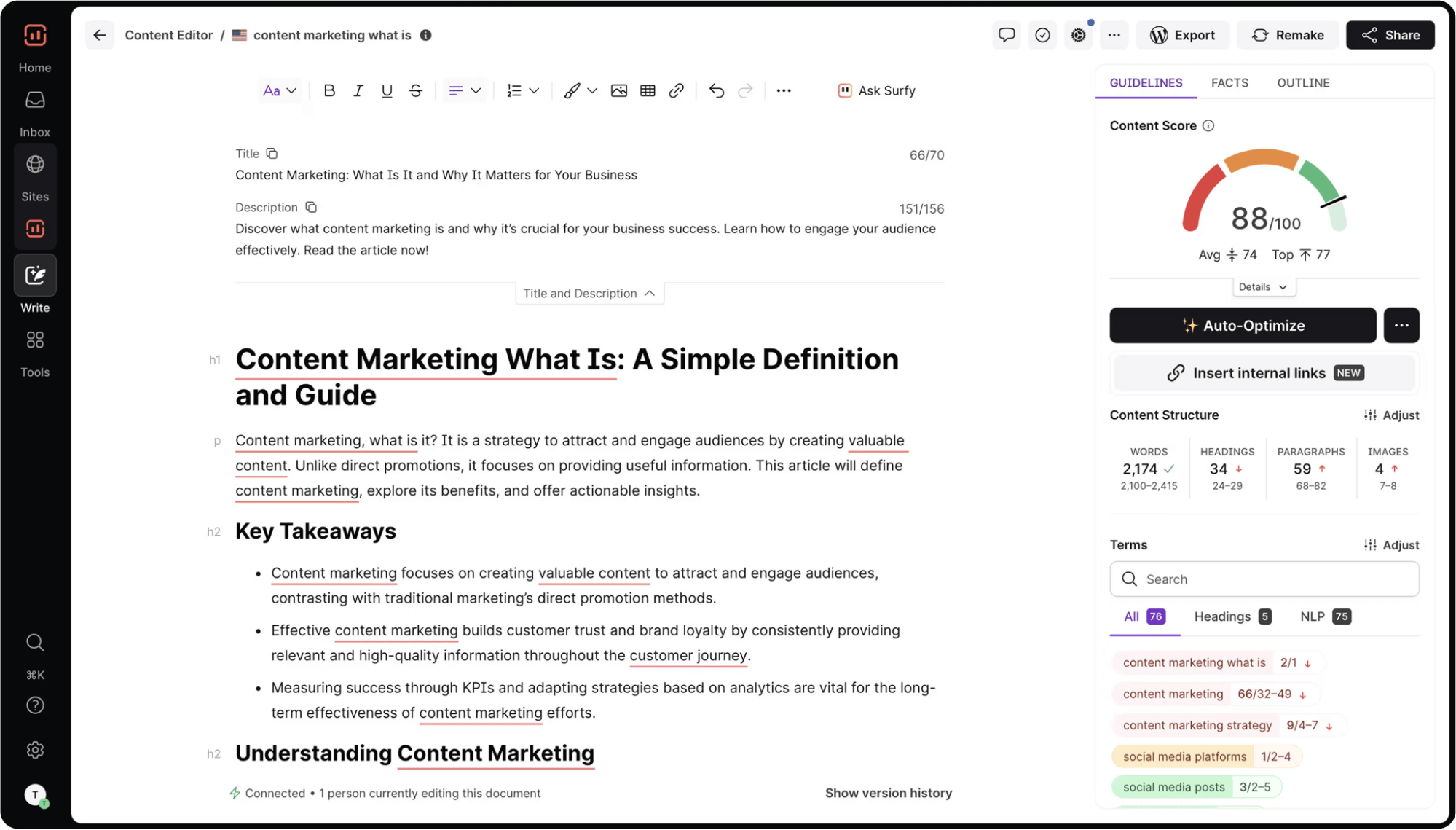
Surfer’s AI generates articles with SEO focus
With a solid draft written, it was time to refine it into a finely tuned SEO machine.
Frase uses a “Topic Score” (a percentage) which is based on a simple concept: how many of the competitors’ key topics have you covered? As we added missing terms from its suggestion list (like “resource allocation” or “kanban board”), our score increased. It’s a great way to ensure topical relevance.
This is where Surfer truly shines and justifies its reputation. The “Content Score” (1-100) is the command center, and the sidebar becomes an incredibly detailed dashboard. It gave us hyper-specific, data-driven targets:
Winner: Surfer SEO.
There’s no contest here. Surfer is the undisputed champion of deep optimization. Its power is backed by a well-known industry study from Originality.ai which found that Surfer’s Content Score has a 28% correlation with higher Google rankings. That’s a tangible data point we can’t ignore. However, a word of warning from our team: don’t become a slave to the score. We’ve seen writers sacrifice readability to cram in one more keyword just to get from 88 to 90. Use Surfer’s recommendations as expert guidance, not as strict rules.
The article is done and optimized. But in 2025, our job isn’t over. We need to promote it.
This is Frase’s secret weapon. We took our finished 3,000-word article, opened the AI Template library, and ran it through several templates:
The entire process took less than 15 minutes.
Surfer has no features designed for this task. Its focus ends once the on-page optimization is complete.
Winner: Frase.
A blog post is an asset, and Frase helps you maximize its return on investment. The ability to instantly repurpose a major piece of content into a week’s worth of promotional material is a massive value proposition for any content writer or marketer.
For years, our mission was clear: get the client on page one of Google. But the game has fundamentally changed. Our readers now get answers from two places: traditional search engines and AI chatbots. A successful content strategy in 2025 must compete in both arenas. This isn’t a future problem; it’s a today problem.
This is where our team had a genuine “wow” moment during the trial. Inside the Frase editor, right next to the familiar “SEO Score,” we saw a new tab: “GEO Score.” It was the first time we’d seen a tool actively measure and guide optimization for AI citations.
Instead of just keywords, Frase’s GEO score is built on three pillars that language models care about most:
Honestly, it felt like we had a coach specifically for writing for AI.
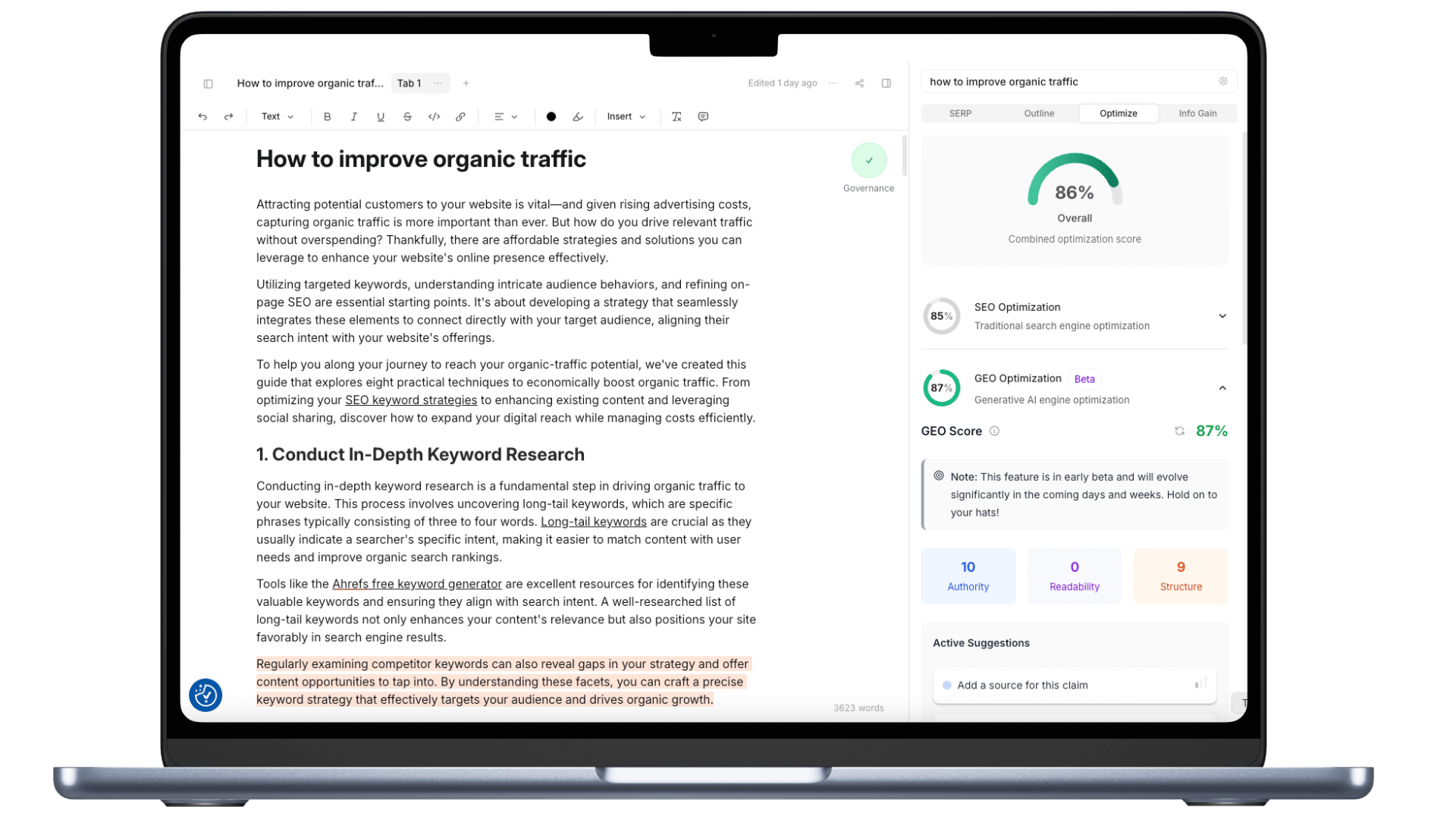
Frase’s GEO Score optimizes content for AI citations and readability
Surfer remains the undisputed master of the traditional SEO game. Its entire system is a perfectly tuned machine for deconstructing Google’s algorithm. We asked ourselves, “Does Surfer prepare us for GEO?”
As of today, the answer is no. Its analysis is 100% focused on the top 10 blue links on Google. It gives no specific feedback on citing sources for authority, simplifying text for readability, or structuring content for AI extraction. It operates on the principle that what ranks on Google will eventually feed the AI models, which isn’t always the case.
Winner: Frase
You may be interested in:
Copy AI vs Frase (2025): Which Is Better for Content Marketing?
Frase.io vs Jasper AI: Which Tool Should Writers Choose in 2025?
Using a tool every day reveals the small things that don’t show up in a feature list. Here are the little details we loved and the things that bugged us.
Frase.io
Surfer SEO
A great tool is only great if it fits the budget. So, let’s break down the real-world cost and value of investing in either Frase or Surfer SEO, focusing on the details that matter most to a writer making a decision.
|
Frase.io |
Surfer SEO |
|
| Free Trial | Yes, a free plan to start. | No, but it offers a money-back guarantee. |
| Credit Card for Trial | No credit card required. | Yes, a subscription is required first. |
| Refund Policy | Not explicitly offered after payment. | Yes, a 7-day money-back guarantee. |
| Annual Savings | 15% savings for annual payment. | 20% savings for annual payment. |
| Team Scalability | Per-user seat model (the Professional plan includes 3 users). | Primarily usage-based (credits), with less focus on user seats at lower tiers. |
| Core Limitation | Plans are limited by the number of “Content Projects” you can create per month. | Plans are limited by the number of “Content Editor” credits you can use per month. |
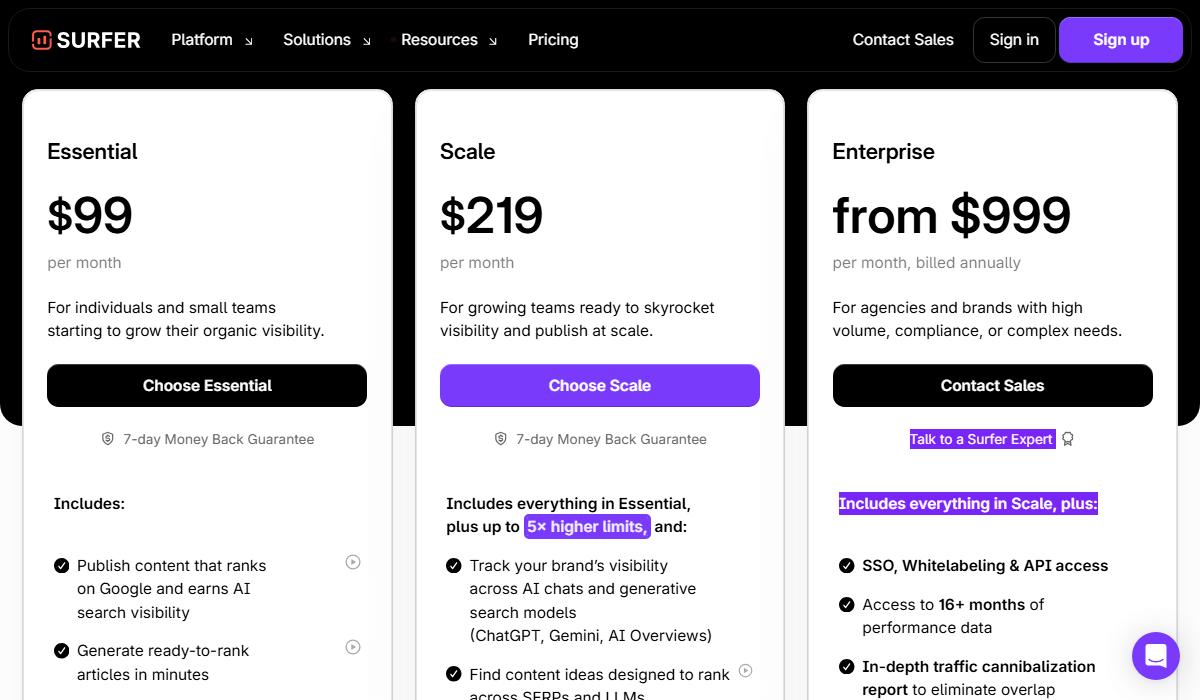
Surfer SEO Pricing Plans
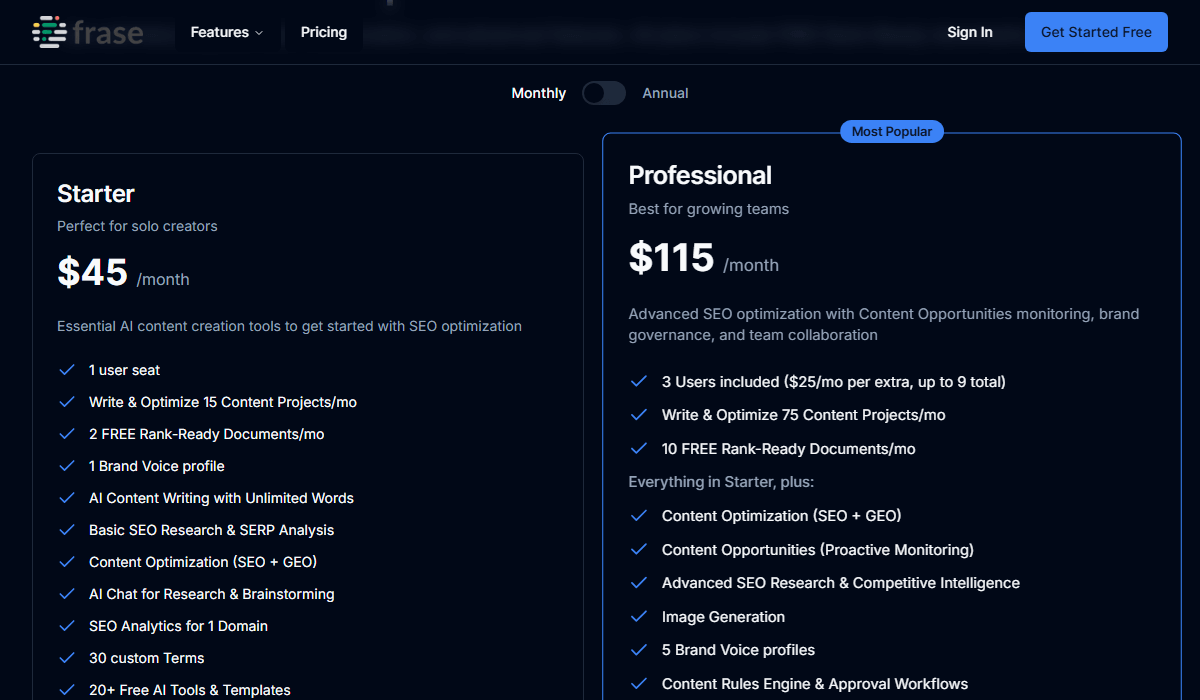
Frase.io Pricing Plans
You may be interested in: Frase vs Writesonic: Which Tool Wins for SEO Writers? [2025]
Our Team’s Choice: After all our testing, Frase.io is the tool we open every single day. It solves more of our daily problems as content writers. While Surfer is an excellent specialist tool we bring out for high-stakes SEO projects, Frase is the better all-around partner for the craft of creating content.
Choose Frase if:
Choose Surfer SEO if:

